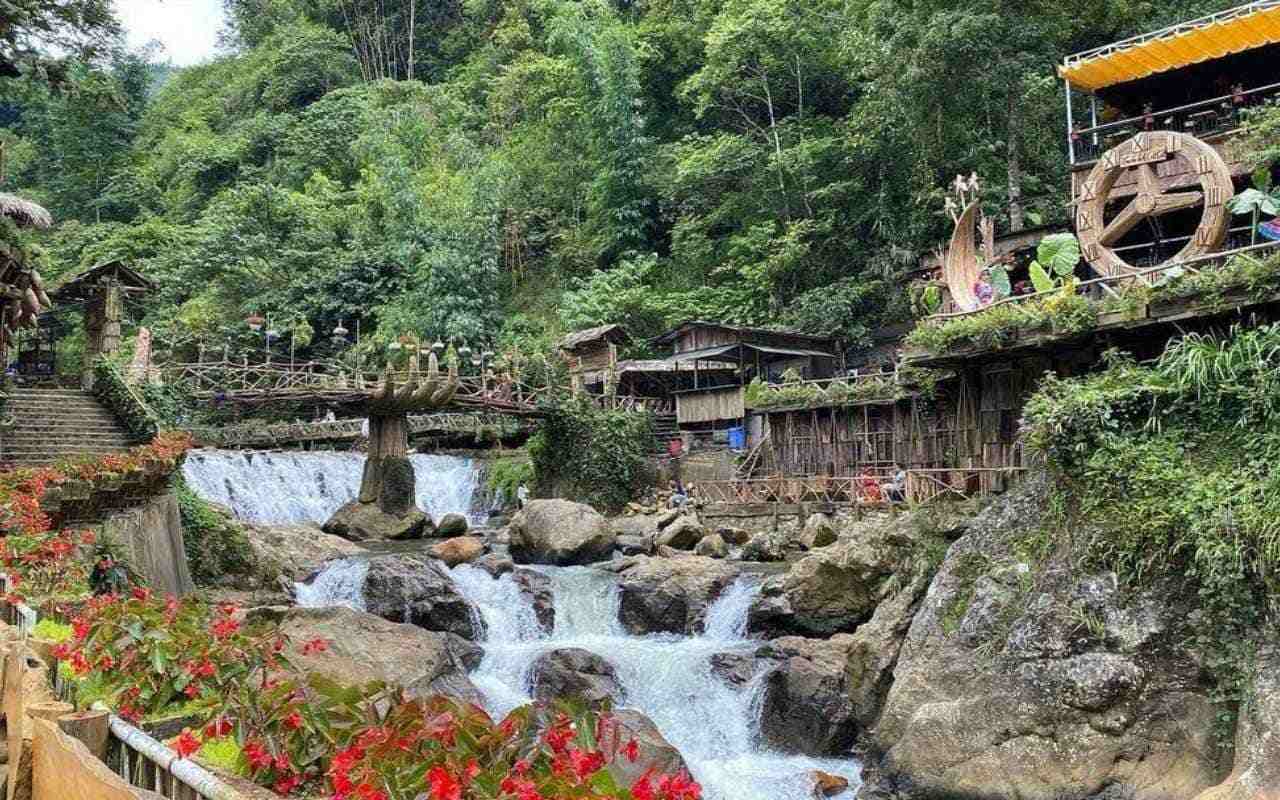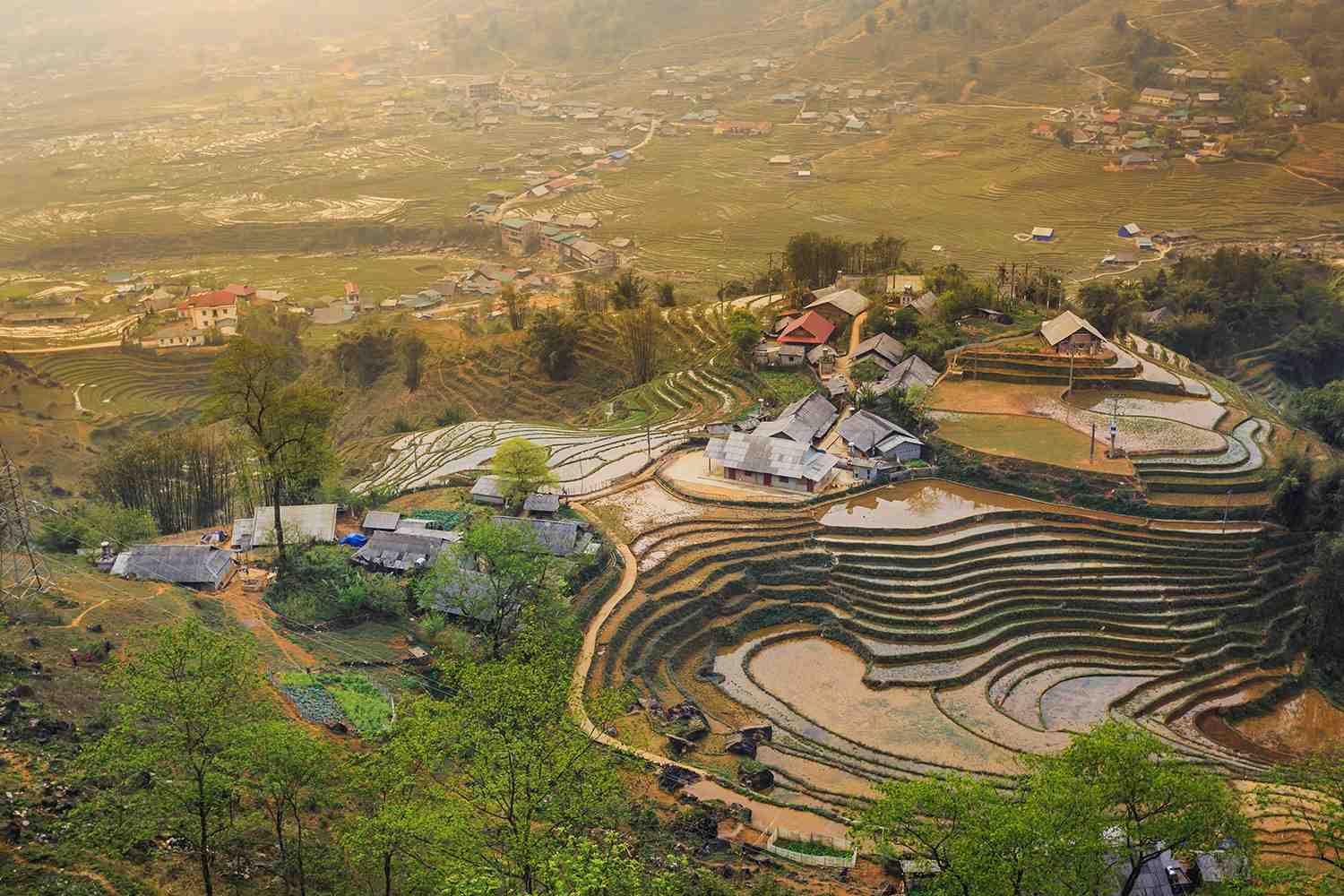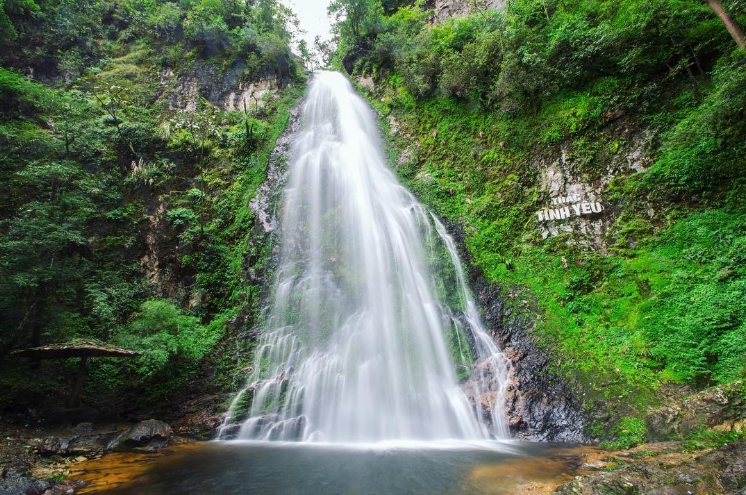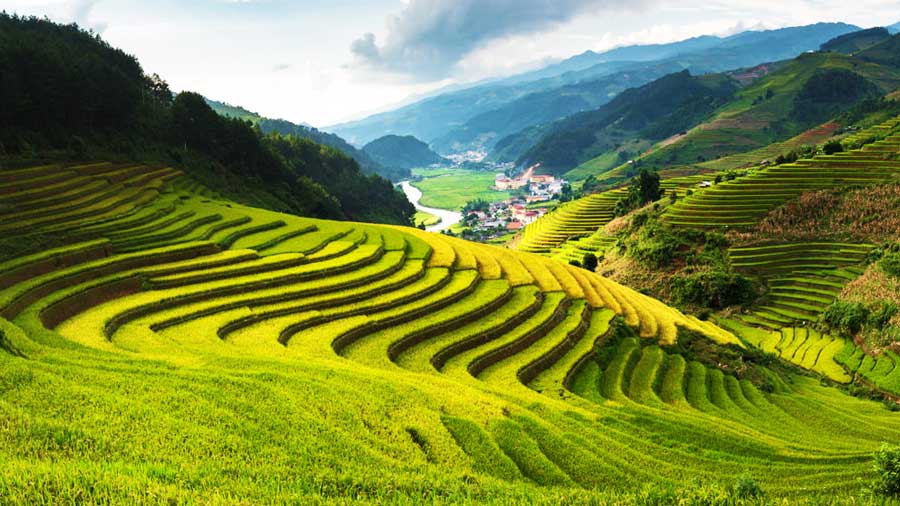1. Some information about Sapa and Sapa Trekking
1.1. Sapa overview
Sapa, located in Northern Vietnam’s Lao Cai Province, is a quiet mountain town and home to many ethnic minorities. Sapa has cool weather—not too hot or too cold. Sapa has a beautiful landscape of “Fansipan, Hoang Lien, and Dragon” mountains and traditional villages such as Lao Chai, Ta Van, Ta Phin, and Cat Cat.
Sapa Lao Cai attracts visitors not only for the beauty of the terraced fields in the ripe rice season but also for the customs and habits of the people here, and the ethnic minorities living in the area are particularly friendly and hospitable.

1.2. Going to Sapa
There are many means of transportation from Hanoi to Sapa, such as sleeper buses, motorbikes, trains, personal cars, etc. Travel time from Hanoi to Sapa is 5 – 8 hours, depending on the vehicle that you choose to use.
1.3. What is trekking?
Trekking is a type of exploratory hiking that involves hiking for days in the outdoors and in the wilderness with a specific purpose. It usually takes place in the suburbs, out of the city, and mostly in the mountainous areas; the trails in the wild areas are relatively unspoiled, and the terrain is rough and jagged, such as in Sapa, Ta Tat, Bidoup, Cat Ba Island, Ta Lien Son, Pu Luong, etc.
The best time to visit Sapa and go trekking is in August and September when the terraced fields are green and yellow, the rice is ripe and golden, and many families are harvesting. During trekking in Sapa, you will move through hills and mountains to see the beautiful scenery of rice fields and traditional villages in Sapa.
2. Prepare things before trekking in Sapa
Before going trekking in Sapa, you need to be fully prepared to have the most convenient and safe trip. You need to prepare the most necessary items and should not bring too many things.
Necessary trekking gear: a travel backpack (with many compartments and that is lightweight); climbing shoes; a hiking stick; a raincoat; a camping tent; pins and tent poles; Sleeping bag, flashlight, and LED light, sleeping bag pads, maps, and GPS navigation devices Knives, multi-tools, medicines, and medical instruments.
Clothing and footwear: a windproof raincoat, a sun hat, gloves, trekking clothes (quick-drying material), hiking shoes, and waterproof sandals.
Personal items: sunscreen, Personal items: brush, toothpaste,…, insect spray, power bank, phone, toilet paper.
Food and drink: instant sausage, cakes, bread, pate, cold meat, dry food; filtered water, mineral salt water, or glucose water when losing strength.
3. The 5 best trekking routes around Sapa town
3.1. Trekking to Cat Cat falls and experience the Cat Cat tourist village
-
- Itinerary: Sapa town – Cat Cat village – Sin Chai village – Sapa town.
- Time: during the day.
- Trekking distance: 7km.
- The travel schedule is as follows:
From the center of Sapa town (the ancient church), you move to Cat Cat village, about 2.2 kilometers from the church. After arriving at Cat Cat Village, you buy tickets to the tourist area and then walk (mainly the stairs) to go inside to visit as well as relax.
Cat Cat is known as the most beautiful ancient village in the Northwest because it has a unique culture, typical traditional architecture, and poetic scenery. Interesting experiences not to be missed when visiting Cat Cat village in Sapa: Admire the terraced fields; explore the traditional craft villages in Cat Cat village (silver making, brocade, linen weaving, knitting); learn about the unique festivals, customs, and habits of the ethnic people; visit the ancient house of the H’Mong people; see the Tien Sa Waterfall; etc.

From Cat Cat village, move in the direction of Muong Hoa valley for about 3 km through terraced fields to reach Sin Chai village. Here you will have the opportunity to admire the traditional wooden houses built with wood from Po mu.
After visiting Sin Chai village, continue the journey to the center of Sapa town. End of the day trekking in Sapa.
3.2. Trekking Sapa – Muong Hoa value
-
- Itinerary: Sapa town – Muong Hoa valley – Y Linh Ho – Lao Chai San – Lao Chai.
- Time: during the day.
- Trekking distance: 10 km.
- The travel schedule is as follows:
The journey begins as you head down to the southeast of Sapa along the Muong Hoa valley. Muong Hoa valley in Sapa is located in Hau Thao commune, where the Muong Hoa stream flows all year round, and clouds and sky shadily embrace each small pass. Muong Hoa Sapa is so beautiful and dreamy; it’s rustic but so ecstatic. Then you follow the hiking path through the ancient villages.

The first destination is Y Linh Ho village. Y Linh Ho is a black H’mong village in Sapa; the atmosphere in the village is very quiet, not noisy, and bustling like tourist attractions inside Sapa town. Learn about the cultural life of the highland ethnic people, stop to rest, admire the most beautiful and wild terraced fields in Y Linh Ho, Lao Chai, and admire the Muong Hoa stream.
End the journey at Lao Chai village and take the car back to Sapa.
3.3. Trekking Silver Waterfall and Love Waterfall
-
- Itinerary: Tram Ton – Love Waterfall – Silver Waterfall – Y Linh Ho – Lao Chai – Ta Van – SaPa town.
- Time: 2 days 1 night.
- Trekking distance: 19 – 35 km.
- The travel schedule is as follows:
Day 1: Sapa – Tram Ton – Love Waterfall – Silver Waterfall – Sin Chai Village
Moving Tram Ton begins the journey from Tram Ton, which is known as the highest pass road in Vietnam with an altitude of about 2047m. From here, you start trekking 11 kilometers along the Yellow River to reach Love Waterfall. After you finish exploring here, you will move to the next location, Silver Falls.

From Silver Waterfall, go down to Muong Hoa Valley and towards Sin Chai Village; this is where the Black H’Mong people live. You will rest and visit here.
Day 2: Y Linh Ho – Lao Chai – Ta Van – Sapa town.
You will continue trekking to Y Linh Ho in Ta Van village. You will go to the suspension bridge, where you will fully admire the natural beauty, watch the Golden River, and hear the rushing waterfalls. Continuing to move up, you will see the ripe rice fields of Lao Chai.
After that, you trek to Ta Van village, where the H’Mong people live, and you will understand their cultural customs. After visiting to learn about the daily lives of the people here, you continue to move to the center of SaPa town, about a 6 km trekking distance away.
3.4. Conquering Fansipan Peak—Indochina Peak
-
- Itinerary: SaPa – Tram Ton – stopover 2800m – Fansipan – SaPa
- Time: 2 days 1 night.
- Trekking distance: 12km.
- The travel schedule is as follows:
Day 1: Sapa – Tram Ton – stopover 2800 m
Moving from SaPa town to Tram Ton Pass, this is the place to start the trekking journey. You will be able to see the beautiful scenery of the mountains. Then, after trekking to the 2800-meter stop, start camping and prepare dinner.
Day 2: Stopover 2800 m – Mount Fansipan – SaPa.
You will see the sunrise here, to prepare for the journey to Fansipan, the roof of Indochina. After reaching the top of the mountain, you can choose to travel by train to reach the landmark.
On the top of Fansipan, there are many sacred architectural works such as the Great Buddha statue, Arhat Road, the Quan Am Bodhisattva Statue, Bich Van Thien Tu, Bao An Thien Tu, etc.
Conquering the tallest flagpole in Indochina: The Fansipan flagpole has a height of 25m and is placed at the highest position on top of the Fansipan. This will be an experience for you to clearly see the pride and deep national pride.

Check in for virtual living with the milestone marked “Roof of Indochina”: Don’t forget to mark a meaningful journey by taking souvenir photos with friends and relatives at the sacred landmark of the country!
See more:
After that, you can get off the train and take a car to Sapa town.
3.5. Trekking Lao Chai, Ta Van, and Giang Ta Chai to see Cau May waterfall
-
- Itinerary: Sapa – Lao Chai – Ta Van – Giang Ta Chai.
- Time: during the day.
- Trekking distance: 10km.
- The travel schedule is as follows:
First, you trek 6km down the southeast side of Sapa along the Muong Hoa valley to the village of Y Linh Ho of the Black H’mong ethnic group. Continue walking 2km to Lao Chai village, through terraced rice fields to Ta Van village of the Giay ethnic people.
Lao Chai village is a commune with more than 100 households of the Black H’Mong ethnic group. Lao Chai,Ta Van village is located in the valley, surrounded by mountains and terraced fields. On the way down to the village, you will admire the long terraced fields, which are arranged in layers like long stairs.

Ta Van village, where mainly the Giay people live with 40 households and a few other ethnic groups. In front of Ta Van is the clear Muong Hoa stream; behind it is the Hoang Lien Son mountain range. You will learn about the daily lives, customs, and habits of the ethnic groups living here.

From Ta Van village, you will go to Giang Ta Chai village to see the Cau May waterfall. Cau May Waterfall and the surrounding area are picturesque. Cau May is considered a part of the breath of the people of Giang Ta Chai. It has a pristine beauty and is mysterious and dreamy, like the soul of the land of fog. It is the stability over time that makes the bridge a very unique ancient feature.

When you are ready to continue, just cross the bridge and follow the path until you reach the main road. On the main road, drive back to Sapa town.
4. Some important notes when trekking sapa
Locals often invite tourists to buy things when they are trekking. Just politely decline if they try to sell.
If you want to buy some souvenirs, you should research the prices of those products and bargain if it feels right.
A normal trekking trip has a length of about 12–15 km per day, so you have to walk for about 5–6 hours. Be prepared physically and mentally.
When you reach the top of the mountain, the air is thin, and because you’ve been active for a long time, it can lead to a feeling of heart attack and chest tightness. You should know exactly when to stop to prevent fainting or, worse, a heart injury. Therefore, when participating in this activity, you should clearly tell the instructor in advance about your health condition to come up with the most suitable route for you.
5. Conclusion
If you want to have interesting experiences in Sapa, try once to go trekking in Sapa! Hopefully, the information in Metta Voyage will bring you useful information. Contact us now to have an enjoyable Sapa trekking experience!
Contact us
Trang web: www.mettavoyage.com
Email: info@mettavoyage.com
Hotline 24/7: + 84 989 383 572



0 Comment